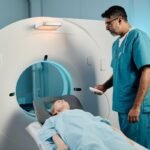Digestive endoscopy is one of the most comprehensive techniques for thoroughly examining the digestive system. Also known as gastroscopy, sedated digestive endoscopy is routine, and preparation is simple: fast for at least 8 hours.
How is a digestive endoscopy performed? Do they put you to sleep for an endoscopy? We’ll tell you all the details about this medical procedure.
What is a digestive endoscopy, and what is it used for?
Digestive endoscopy is a test to examine the upper digestive tract, which includes the esophagus, stomach, and duodenum. It is performed by inserting an endoscope with a camera through the mouth to detect diseases.
This procedure is useful for checking the condition of the digestive tract lining. It also facilitates other procedures such as biopsies or even the removal of polyps or nodules.
This procedure uses a flexible tube called an endoscope with a lens and camera at one end. Images are displayed in real time and projected onto a screen monitored by the doctor.
How is a digestive endoscopy performed? Steps and procedures
The truth is that this procedure isn’t particularly complicated. This is how a digestive endoscopy is performed.
Digestive endoscopy: preparation
For the patient, preparation for this test consists solely of avoiding eating and drinking for 8 hours before the procedure. Patients should also discontinue their usual medications unless otherwise directed by the specialist.
To perform the test, the patient must lie on their side on the examination table in a resting position. Some people even fall asleep during the test.
Importance of sedation in digestive endoscopy
During the medical procedure, it’s common for the patient to experience some discomfort and nausea. For this reason, gastrointestinal endoscopy with sedation is sometimes necessary. This allows the patient to relax.
It is common for the patient to gargle with a liquid medication or spray the throat to soothe the area and prevent nausea during the procedure.
What type of anesthesia is used in endoscopy?
Tolerance for an endoscopy varies from patient to patient. Some people experience mild discomfort but cope calmly with the procedure. However, others require more relaxation. Therefore, there are three types of sedation for endoscopy:
- Conscious sedation. The person remains fully alert and responds to any verbal stimuli. Local anesthesia is applied to relax the area.
- Deep sedation. This sedation is more intense, and the patient only responds to painful stimuli. Respiratory support is sometimes necessary.
- General sedation . The patient is completely asleep during the procedure and requires intubation. For digestive endoscopy, this type of anesthesia is always the last option.
What is the purpose of the digestive endoscopy test?
There are many advantages to performing an upper gastrointestinal endoscopy to treat conditions affecting the stomach, esophagus, and duodenum. Experts use it to:
- Treat bleeding caused by ulcers.
- Remove objects or food that have become trapped in the digestive system.
- Remove polyps.
- Place drainage tubes.
This test is also performed to diagnose the following diseases:
- Cancer.
- Celiac disease.
- Ulcers.
- Gastric reflux.
- Narrowing of the esophagus.
- Acidity.
- Swallowing problems.
- Weight loss for no apparent reason.
- Bleeding.
- Tumors.
It also allows biopsies to be performed using an endoscope to obtain a sample that can be used to diagnose a disease.
Is a biopsy always performed during an endoscopy?
An endoscopy doesn’t always involve a biopsy. There are procedures, such as removing targets or preparing for surgery with a drainage tube, but it isn’t necessary.
How long does a digestive endoscopy take?
The duration of a digestive endoscopy does not exceed 10 or 15 minutes and is usually performed with conscious sedation of the patient.
Does the digestive endoscopy test hurt?
Digestive endoscopy is a painless procedure. Some patients may experience nausea during the examination, and discomfort is normal after an endoscopy.
Types of digestive endoscopy
There are two types, depending on the part of the digestive system to be treated.
Upper gastrointestinal endoscopy
Upper gastrointestinal endoscopy allows access to the esophagus, stomach, and duodenum. The latter is the part of the small intestine closest to the stomach. To perform it, a tube is inserted through the patient’s mouth and descends into the duodenum.
Lower gastrointestinal endoscopy
Lower gastrointestinal endoscopy, on the other hand, allows observation of the large intestine and the ileum, which is the part of the small intestine closest to the large intestine. To perform this type of examination, a tube is inserted through the rectum and guided through the large intestine.
What is the difference between a gastroscopy and an endoscopy?
In practice, there is no difference between gastroscopy and digestive endoscopy. Specialists use the terms similarly.
Risks associated with digestive endoscopy
Endoscopies are safe medical procedures that are performed daily with few complications. However, it’s important to understand the risks of any medical procedure before undergoing it.
- Bleeding in the areas where the polyp was removed. Light bleeding is normal.
- Deterioration or perforation of the lining of the digestive tract. If this is the case, the surgeon may propose surgery to resolve this complication.
- Respiratory or heart problems resulting from an adverse reaction to sedation.
How much does a digestive endoscopy cost in Spain?
The cost of a digestive endoscopy in Spain, performed by private healthcare providers, ranges between 240 and 470 euros. It includes the diagnostic test and patient sedation.
Frequently Asked Questions
Do you have to undress for a gastroscopy?
Some medical centers will ask you to undress and wear a hospital gown for the gastroscopy. It’s recommended that you wear loose clothing, avoid makeup, and avoid wearing accessories or jewelry.
Do they put you to sleep for an endoscopy?
Endoscopy tests usually require light sedation , although they rarely put the patient to sleep completely . The patient usually responds to painful stimuli.




















+ There are no comments
Add yours